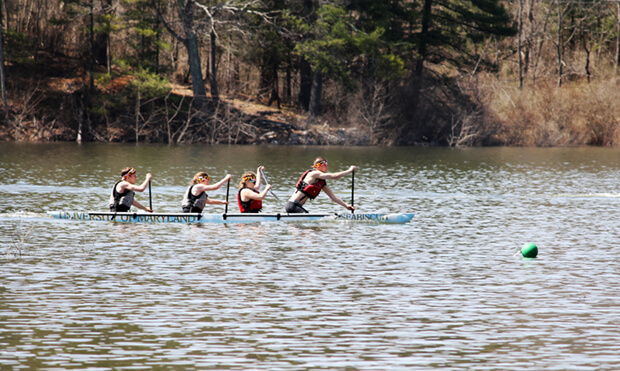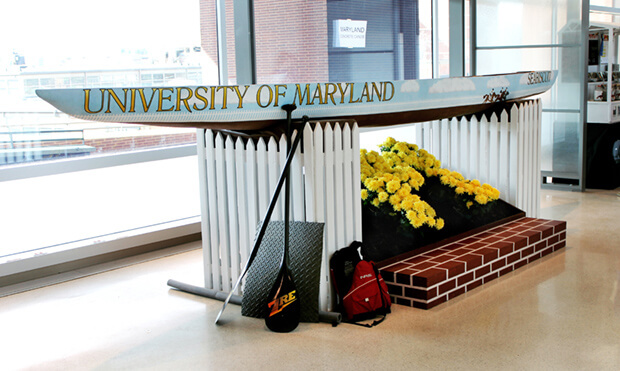- June 16, 2015
- By Lauren Brown
Like the legendary racehorse it’s named for, a canoe called Seabiscuit is helping Maryland engineering students make a comeback.
A team of 40 undergraduates has designed and built a 195-pound boat made of concrete, and it’s headed to the national collegiate finals June 20-22 at Clemson University. It will be Maryland’s first time back in the competition since 2003.
Yes, the UMD entry—a surprisingly sleek 195-pounder—floats, and gracefully so. It easily carried four members who paddled it to win the Mid-Atlantic regionals in April.
“I thought we’d get top three, but first was definitely a surprise,” says Phil Izzo ’15, one of two project managers. “When they called that we got first overall, I stood up, screamed very loudly and kind of flexed everything.”
A primary goal of the contest, sponsored by the American Society of Civil Engineers, is to give civil engineering students an opportunity to get hands-on experience working with concrete mix designs and as a team to manage a project.
Concrete is a man-made material of cement, water and an aggregate such as sand or stone. It has a long history in boat construction: Warships made of concrete were deployed in both world wars because of steel shortages.
All entries in this “America’s Cup of Civil Engineering” must be able to remain afloat when filled with water and two 25-pound sandbags, measure no more than 22 feet long and 3 feet wide, and be able to fit two men and two women.
At Maryland, the design and construction process lasts a full academic year; the team of up to 70 members started out last fall seeking to improve the previous year’s entry in regionals, Poseidon. They first created four designs using marine design software, slimming down from the 2014 model, and then made 1/10-scale models to test each one for maneuverability and speed.
Then they had to come up with their custom concrete mix that, compared to last year’s version, was less dense (and therefore rides higher and creates less drag for the paddlers) and easier to spread and smooth out. The aggregate they settled on was made partly of recycled glass, and they also added water- and shrinkage-reducing and super-plasticizing chemicals.
That’s when Danielle Neumeister ’16 joined the team. “I went by one day when they were mixing concrete, and I never left,” she says. “This project has so many different parts—there’s something in it for everybody.”
The students had a mold made of their most successful test design, and they layered the concrete with strengthening materials including fiberglass mesh, steel mesh wire and microfibers, first in a practice version, then the real deal.
The wet mold went into a curing chamber (really a wood box with a plastic tarp) for 21 days, and then, when the cement was hard and dry, they broke the mold off with shovels and hand tools.
Izzo says he and his teammates then sanded the boat for hours every day for two weeks. The result: a canoe with a hull less than an inch thick in parts, so smooth that it could easily be mistaken for painted wood.
For the design theme, the team chose the Preakness Stakes, the Triple Crown race that’s taken place in Maryland since 1873. The legendary Seabiscuit was a mediocre-performing thoroughbred that came back to win at Pimlico in 1938 in what’s considered one of the greatest races in history.
The UMD students’ Seabiscuit also features more than a hundred hand-painted black-eyed Susans (the state flower that is also displayed at the race) inside the hull, a horseshoe on the top, and several jockeys hunched over racehorses along the side—all done by students.
“The students learn a lot of great teamwork skills because they’re spending lots of long hours with the same people and learning to delegate tasks and get along with their coworkers, and in the end produce a winning final product,” says faculty adviser Brian Phillips, an assistant professor.
The ASCE race goes back 28 years, and Maryland placed three times in the top five nationally before the team went dormant for a few years. Reinstated in 2003, the team came in second at regionals last year but hadn’t won them until 2015.
At the regional competition at Penn State April 10-12, Maryland’s Concrete Canoe and Steel Bridge teams both placed first overall in their team competitions and second in the technical paper competition. Last month, the Steel Bridge team came in 17th out of more than 200 competing at the national competition in Kansas City, Miss.
“Both teams are a great way for engineering students to make new friends and develop relationships with underclassmen,” says ASCE Maryland President Jonathan Schneider ’15.

Tags
Student Experience